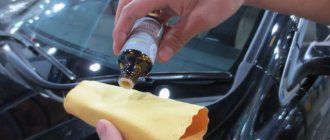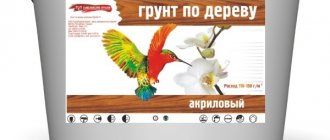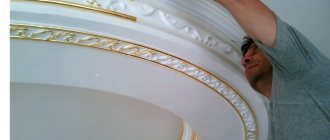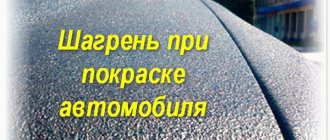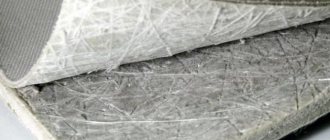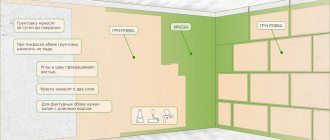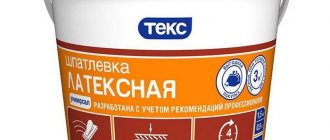How to degrease the surface for painting?
Which degreaser is needed in a particular case: wood, plastic, glass, metal, etc.?
The fact is that it is better to degrease the surface for painting with those chemicals (solvents) that are compatible with the paints with which you will then paint this surface. And here it is good to remember the experience of our ancestors. For example, if you paint with oil paint, then it is better for you to use turpentine for degreasing. The fact is that even artists who painted icons used turpentine for these purposes, since even if a small amount of it remained on the surface, it did not affect the quality of the paint with which you then painted the surface, the same applies to other paints — it is better to degrease with the solvent that is included in the paints.
Before finishing any surfaces, be it applying paint or varnish, wallpapering or applying other coatings, the surface must always be cleaned and degreased. The can of paint that you choose to paint a specific surface should indicate what product should be used to degrease and thin the paint. You can use universal products, such as white alcohol, gasoline or acetone.
The metal surface is degreased with white spirit or solvent, possibly gasoline, kerosene or freon (fences, railings). For wood and rubber it is better to use gasoline. Glass can be wiped with a sponge moistened with ammonia or white alcohol, and stones with alcohol. For plastic, select neutral and soft reagents, for example, PiTon in aerosols or anti-silicone and special removers APP W900, APP WK900.
Before applying paint to the surface, it must first be degreased. Indeed, thanks to degreasing, the adhesion process will be most effective.
If the surface is metal, then you can use white spirit, solvent, or kerosene as a degreasing agent.
If the material is wood, then gasoline can be used.
When working with plastic, you should opt for soft, gentle products, for example Piton or APP WK900.
Glass can be wiped with solvent and alcohol.
The degreasing process is simple, first we remove dust if there is any on the surface, then we proceed to processing.
In the case of large areas, you can use a brush or rag. Apply to a rag and wipe the surface to be painted.
If the area is not very large, then you can use a sponge.
Degreasing is a process by which fat and other contaminants are removed from the surface of materials.
Thanks to degreasing, paint adhesion to the surface improves.
Now there is a product on sale called “degreaser”, for example this one from “Yashim”,
In general, you can degrease it with alcohol and solvents, kerosene, White Spirit, gasoline, too, but I don’t recommend it, this is the worst option, because it contains oily substances.
As for how, depending on what we are degreasing, if it is metal and the area is large, for example a car, before painting, then the best option is a rag, moisten the rag in a degreaser and wipe the surface with it, a rag is convenient, because a large area is captured and as work progresses degreasing, removing dust from the surface.
On smaller areas, you can apply a degreaser with a sponge, depending on your convenience.
Degreasing before painting is a process on which the success and durability of the repair depends. Regardless of the type of surface, you can use the following factory products, which are essentially universal:
- Soll >
I personally tested some of these tools, and I heard good reviews about others from colleagues.
But I rarely use such degreasers, only when I need to clean the surface from any technical liquids, grease, silicone, etc. In other cases, preference should be given to cheaper options, simply to save money. Alcohol, septocide, acetone, gasoline, and white spirit are suitable.
The degreasing method depends on the area that needs to be treated. Small parts can be treated with a piece of cotton wool with a solution applied to it, large surfaces can be wiped with a rag.
This largely depends on two factors, so degreasing can be done in 2 stages.
1 factor is the material that must be washed off from the surface before painting. For example, it is necessary to paint a metal surface that is contaminated with grease. Solid oil is easily washed off with gasoline, so the surface must first be degreased with gasoline. but some paints do not accept gasoline, so you have to re-degrease the surface with a certain solvent, see how it is selected below.
Factor 2 is the compatibility of the paint and the solvent that will be used to degrease the surface. It is best to first select a paint and read the instructions about which solvents are suitable for this product before purchasing a degreasing solvent. These are the solvents that should be used to degrease. The exception, of course, is water-based paints and some oil paints. For these paints, the best option is white spirit.
Degreasing should be carried out with a cloth soaked in solvent that does not leave lint. Hard-to-reach places can be sprayed through the dispenser.
The need to prepare metal products for painting is due to an increase in the adhesion characteristics of the substrate to the paint and varnish material and the resistance of the metal to corrosion processes. All this will have a positive effect on the service life of the painted products. However, most owners are much more concerned about the presence of rust, which must be removed during the metal preparation process, than about degreasing, which is why painting work is carried out without this important and mandatory operation.
Answers
Himonas 7 (36803) 5 11 36 6 years
I have never encountered such a problem.
dika_klasnaya7 6 years
here’s a topic for you, everything is written there: https://forum.sibcolor.ru/index.php?topic=64.0
blblblbl 8 (115652) 8 15 115 6 years
Wrong soil. In principle, the soil is not degreased. Its functions are improved adhesion to paint and to the base. If it washes off with paint, look for a different primer. Or another paint. There won't be any sense
iljaajli 4 (1775) 3 11 6 years
a degreaser where they sell paint, so to speak. It smells like kerosene.
cnapmak (29) 4 (1608) 6 18 6 years
timurcik9 6 (12345) 2 6 14 6 years
The soil cannot be treated with anything! This is a special coating to bind the surface itself to the paint. After priming, you don’t need to touch it with your hands; apply paint right away. In extreme cases, you can wipe with neutral solvents, but you need to know the base of the soil, it can be pure alcohol or pure gasoline. It all depends on what the base of the soil is.
blush 2 (435) 1 2 6 6 years
anti-silicone and other degreasers
Is it necessary to degrease the primer before painting in order to end up with a perfect, even layer of enamel with high protective characteristics? Is it worth saving at this stage, risking further loss of the attractive appearance of the surface and reducing the effectiveness of its protection from adverse external conditions? What benefits does this operation provide if you do not ignore it?
Any product coming out of the production walls, as a rule, has a high-quality paint and varnish coating. It’s nice to look, for example, at a shiny new car or a snow-white refrigerator in your kitchen. But how is such perfection achieved?
Modern painting technologies include many seemingly insignificant, but very important operations. The main ones are preparation of the part, priming and final painting. But still, a real masterpiece can only be obtained by using certain subtleties in this difficult matter.
For example, the question: is it necessary to degrease the primer before painting in modern production is not even raised. This is a completely standard operation. The effect of its use cannot be overestimated - increased durability, durability of the coating, absence of defects. After all, it is precisely these parameters that technologists around the world strive for.
While developing new ways of applying paint and varnish, they do not forget to pay close attention to materials for those very, relatively speaking, minor operations.
Thus, a whole range of new special products for degreasing surfaces before painting has appeared. The newest chemicals have replaced controversial, outdated solvents and acetones.
Preparing the body part for painting. Detailed instructions!
We often get asked questions about how to properly prepare a body part for painting. In response to these questions, we have prepared detailed instructions on how to do this correctly.
Attention! If you need to paint a new body part, you must first remove the “transport primer” from it.
1.
Remove dirt and thoroughly degrease the surface. To do this, it is best to use the KUDO KU-9100 silicone remover and a clean cloth.
2.
To impart anti-corrosion resistance to the surface and improve the adhesion of subsequent layers, apply universal primer KUDO KU-200x. From a distance of 25-30 cm, apply the primer evenly in two layers with intermediate drying for 10-15 minutes. Complete drying time is 2 hours at 20°C.
3.
We apply 1K acrylic primer-filler KUDO KU-22xx. From a distance of 25-30 cm, apply the primer evenly in two layers with intermediate drying between layers of 5-10 minutes. Complete drying time is 1.5 hours at 20°C. (or 30 minutes at 60°C).
4.
After the primer has dried, the surface can be sanded.
For dry sanding, use P400-P500 sandpaper, and for wet sanding, P800-P1000. Before painting after sanding, do not forget to degrease the surface with KUDO KU-9100 silicone remover. It is not recommended to use other solvents
.
Important! A surface coated with 1K acrylic primer-filler KUDO KU-22xx can be painted with any type of enamels.
Attention! At the end of the work, so that the spray head does not become clogged, turn the container upside down and spray until the composition stops flowing.
Since it is better to see once than to hear a hundred times, we made a detailed video instruction on preparing a body part for painting using KUDO aerosol materials. When painting, we used silicone remover KUDO KU-9100, universal primer KUDO KU-200x, 1K acrylic primer-filler KUDO KU-22xx.
Surface degreasing agents
The process of degreasing a surface requires a special attitude towards the chemicals used in its treatment. Of great importance are the improved cleaning properties of the new drugs, as well as the ability to quickly and completely evaporate from the surface, which emphasizes their effectiveness. Also, which is important, you need to take into account safety when working with them, lack of toxicity and strong odors, ease of use when applied to the surface.
The dissolution of oil or grease stains occurs much more efficiently, which increases the coefficient of adhesion of the base plane to the paint film. The resistance of the painted part to adverse environmental conditions increases. The adhesion property of the soil layer increases. Consequently, the durability of the paint coating increases, and the possibility of defects in the finish coating during operation tends to zero.
Using special products, you will not have the problem of washing off the previous layer due to the excessive aggressiveness of the cleaning liquid.
The main advantage is that the new chemicals dissolve and instantly wash away the fat or oil film. As a result, enamel, paint or varnish is applied to a completely degreased finished surface in a completely even layer. This property of new special fat-dissolving substances provides a tremendous advantage over old products.
Is it necessary to degrease the primer before painting so that the paint goes on smoothly, does not leave drips or streaks, and pleases the eye with its freshness and beauty for a long time? The positive answer is obvious.
When using degreasing, before applying paint to the primer, maximum cleansing of the surface is achieved, because even in the short time that passes between priming and painting, accidentally formed grease stains may appear on the surface. For example, the air flow from a spray gun can emit oil particles that need to be removed. If this is not done, then bubbles may appear on the dried surface, and in the future the paint will peel off and peel off, opening the way for corrosion processes.
Alkaline degreasers
Alkali-based degreasing solutions are characterized by a number of advantages:
- high efficiency, including against high levels of pollution;
- low harmfulness;
- no fire hazard;
- environmental friendliness;
- various methods of application to the surface.
During interaction with alkaline solutions, saponified fatty compounds are destroyed. Unsaponifiables form an emulsion and are removed along with it. A significant disadvantage of alkaline solutions is that after treatment they must be protected against corrosion.
Surface-active substances very effectively dissolve fatty contaminants. When it comes into contact with dirty areas, foam is formed, which reduces surface tension and the adhesion force of molecules to each other. Contaminants in solid and liquid form are destroyed and turn into solutions and emulsions, which are then easy to remove. Surface degreasing products contain up to 10% surfactants.
The purpose of degreasing the primer layer before painting
- The material lays down in a more even layer and, as a result, less varnish, paint or enamel is consumed.
- No paint defects.
- More attractive appearance of the product.
- The durability of the coating increases.
A high-quality paint coating is impossible without the appropriate level of surface degreasing. To do this, you need to use modern cleaning products. And so that your product, machine, tank or, ultimately, fence, makes your eyes stop at them, do not skip a single stage when painting, use only advanced technologies. Whether it is necessary to degrease the primer before painting is currently a question for amateurs. It is absolutely clear that without this important process it is impossible to obtain a perfect paint finish.
The need to prepare metal products for painting is due to an increase in the adhesion characteristics of the substrate to the paint and varnish material and the resistance of the metal to corrosion processes. All this will have a positive effect on the service life of the painted products. However, most owners are much more concerned about the presence of rust, which must be removed during the metal preparation process, than about degreasing, which is why painting work is carried out without this important and mandatory operation.
What is defatting
The essence of the procedure is to remove fatty substances from the surface of the substrate, which are often present in cooling emulsions, mineral oils, preservative lubricants, and polishing compounds. Degreasing of the metal surface before painting also has to be done to remove residues from washing and etching, traces of sweat and fingers. All these contaminants can extremely negatively affect the quality of surface wetting with paints and varnishes, as well as harm film formation and other properties of the coating.
Depending on the amount of fatty impurities present per square meter, several degrees of surface contamination can be distinguished:
- Weak - up to 1 g;
- Medium - from 1 to 5 g;
- Increased - more than 5 g.
When processing fats with chemical reagents, several sequential processes occur on the surface:
Depending on the ability of fats to be destroyed under the influence of solvents, several types of contaminants are distinguished:
- Non-destructible - for example, emulsions.
- Pollinated - polishing materials, lubricant residues.
Chemical methods
The main type is organic solvents, which allow you to quickly remove grease and oily areas from metal parts. They are most widely used in individual production, although sometimes they are used in serial production, but not often due to their high explosion and fire hazard. The desired effect, namely the dissolution of oil and fat deposits, is achieved at the moment of contact of organic solvents with them.
The quality of surface degreasing is directly affected by the degree of solvent contamination, since the more fats are contained on the surface, the worse the chemical’s ability to dissolve existing deposits becomes. Most often, aliphatic and chlorinated solvents are used to remove fat and oil areas. Despite their high efficiency in metal cleaning, they have a serious drawback - these compounds are not able to remove abrasive materials and other mineral contaminants from the surface.
Aqueous solutions
As is known, water has poor purification ability, which is associated with significant surface tension and incompatibility with fats. Therefore, when it wets greasy surfaces, stable emulsions are not formed. To increase the cleaning properties of an aqueous solution, manufacturers resort to various techniques - increasing the pH acidity level, increasing the temperature regime of use to the range of 50-65 degrees Celsius, and introducing surfactants into the composition.
Alkaline degreasers
These compounds have a lot of positive properties. These include high cleaning ability, fire safety, environmental friendliness, and a wide selection of application methods. When treated with aqueous solutions of saponified fats and oils, the latter are inevitably destroyed, and unsaponifiable contaminants are emulsified. The latter case can be described as the process of detachment of fatty layers from the surface with gradual transformation into a working liquid and removal along with the working solution. The main disadvantage of these compositions is the need for anti-corrosion treatment of the surface after cleaning.
Among the components present in cleaning solutions, surfactants - surfactants - deal best with fatty and oily areas. Once on the surface, they form foam on it, simultaneously reducing interfacial and surface tension, increasing wettability and destroying solid and liquid contaminants, transforming them into a more convenient form for removal. The surfactant content in grease cleaners , as a rule, fluctuates within 10%.
If the need arises, along with degreasing, to remove thin oxide or hydroxide films, acidic solutions containing 1-3% phosphoric acid are used.
After treating surfaces with cleaning compounds, they must be washed with water. The presence of salt residues is unacceptable, since they can destroy the properties of paint films, increasing moisture permeability and accelerating the development of under-film corrosion.
Emulsion compositions
In cases where there is a need to remove oil deposits, grease, and difficult-to-remove contaminants from the surface, emulsion degreasing is used. This method is combined and has the advantages of organic solvents and aqueous alkaline solutions. These compositions contain emulsions of solvents and surfactants diluted with water. Chlorinated or aliphatic hydrocarbons can be used as solvents.
Ultrasonic and electrochemical methods
To increase the cleaning ability of detergent compositions, special baths with an ultrasonic field are used. This method is most relevant for small-sized products with a highly complex surface, for which it is important to remove contaminants with the highest quality possible. For large parts, it is not practical to use this method due to economic considerations, since there is a need to increase the output power of the device.
When preparing metal products using the electrochemical degreasing method, specially equipped baths are also used, and the process itself is carried out due to the action of gas bubbles formed on the electrodes. This makes it possible to reduce the consumption of components of chemical compositions and improve the quality of surface treatment.
Chemical methods
The most common and easiest to use are chemical methods for degreasing surfaces.
Most often, organic solvents are used to degrease the surface. They are especially popular among home craftsmen and small workshops. Large industries try to avoid this class of products due to their high fire hazard and toxicity.
The principle of operation of organic solvents is to dissolve the contaminated layer and then remove it from the surface with a dry cloth.
The effectiveness of such products directly depends on the degree of contamination of the solvent itself - a certain volume of it can also dissolve a strictly defined amount of fatty contaminants. After reaching a certain level of contamination, the solvent is no longer able to degrease the part. Therefore, it is necessary to change wipes more often and moisten them with fresh solvent.
Organic solvents can degrease with high efficiency, but have one drawback. They cannot remove mechanical impurities, abrasive residues, etc. from the surface.
How to degrease metal before painting
In domestic conditions, owners, as a rule, use proven “old-fashioned” products - gasoline, kerosene, acetone, alcohol.
But today more modern and technologically advanced formulations are available. Among them, Nefras (White Spirit), Solvent 646 are quite popular. They have a lot of advantages - affordable price, increased level of environmental friendliness, the ability to form films that are more resistant to paintwork, which helps prevent the development of corrosion processes.
The problem for many owners is that the substrate after degreasing does not match the chosen paint. This can be avoided by purchasing a solvent suitable for the coating being treated. But more often than not, such problems do not arise when using solvent No. 646 . Consumer reviews talk about its versatility, so there is no need to carry out additional operations.
Another popular type of solvent is Antisilicone. These compounds are in high demand among craftsmen, who use them to degrease the car body before subsequent painting. However, safety rules must be observed during operation. In the room where degreasing work is carried out, windows and doors must be opened. Such solvents can be used as far as possible from sources of ignition and always wearing personal protective equipment.
The most effective are special concentrated solutions - Chistomet, Docker Dekamet and others. The main active component in these products is alkali. They also contain additional substances - inhibitors, surfactants, additives, etc. Before use, the concentrate is mixed with water in pre-calculated proportions. It all depends on the degree of contamination of the surface being treated. The advantages of these solutions are their high environmental friendliness and safety. They can be used not only to degrease the surface, but also to increase the anti-corrosion resistance of the metal. Can be used in industrial enterprises.
Removing dust
So, our car is covered and degreased. The final touch, marking the end of the preparation stage and the body's readiness for painting, will be removing dust using a sticky cloth and compressed air.
A blow gun will help remove dust from the surface to be painted, and at the same time once again check the quality of fastening of the masking materials.
You need to blow air on the car with the hood on. Blow not only the surfaces to be painted, but also the masked areas. At the same time, check again that the camouflage materials are securely fastened. We blow through all the cracks, openings, etc. to make sure there is no dust or debris that, when painted, can get onto the surface and ruin the paintwork.
Don't forget to blow off your clothes and shoes as well. It is also worth blowing out the spray gun itself and wiping the air hose connected to it.
Dust collection adhesive cloth - an indispensable assistant in dust removal
A special dust-collecting sticky napkin will be an indispensable assistant in dust removal. Just be careful not to press too hard when wiping, otherwise the sticky substance that the napkin is soaked in may remain on the surface. Wipe with light movements, without fanaticism.
At this point, the stage of preparing the surface for painting can be considered completely completed, for which we congratulate you! Now you can thin the paint, adjust the spray gun and paint. But more about this in future publications.
Popular solvents
How to degrease a metal surface before painting is a pressing question for many owners. To degrease metal surfaces, today you can use not only affordable and time-tested compounds, but also modern solvents.
White spirit
Among degreasers, white spirit is most often used. It looks like a transparent, colorless liquid with a characteristic odor of fuel and lubricants.
It is sold in stores under the name “Nefras-S4” and is available in various modifications. The main reason for its popularity is due to its versatility.
This solvent can easily remove any oils and fats, as well as many organic compounds. It is often used to dilute oil paints, enamels and varnishes. White spirit also has one more positive property - after treating the surface, you do not need to wait for it to dry; you can immediately proceed to applying a primer or paint material. The solvent evaporates very quickly, and this is what gives it superiority over other cleaning compounds.
Solvent 646
This type of degreaser is widely used when preparing for painting. It is a yellowish liquid with a strong characteristic odor. It has a fairly wide range of applications.
With this composition you can not only dilute paints, but also degrease metal surfaces. It is especially effective when you need to remove old layers of paint. Can be used for washing painting equipment and tools.
Best suited for diluting the following types of enamels:
- nitrocellulose NC;
- glypthal GF;
- melaninoamide MPs;
- acrylic;
- epoxy.
When using the degreaser, it is necessary to observe the temperature recommended by the manufacturer from + 5 to + 30 degrees Celsius, while the air humidity should not be higher than 85%. Then, after treatment, the metal surface will acquire a shiny, glossy appearance without stains or streaks.
Please remember that Solvent 646 is a flammable and explosive product. You can work with it only while wearing respiratory, eye and skin protection. When carrying out work indoors, it is necessary to ensure the supply of fresh air through windows and doors or through working exhaust ventilation.
Acetone: classic
Another fairly common metal degreaser. In terms of its composition, it is a transparent liquid with a strong characteristic odor. Excellent for removing oil and grease stains, as well as tar.
Acetone can be used to dilute varnishes, enamels, paints and primers. Sometimes it is added to the composition of some solvents. The main component is alcohol, which is highly volatile.
To protect metal surfaces from corrosion processes, they must be specially treated before applying paint. Dyeing technology requires an operation such as degreasing. It can be performed using various solvents and degreasing compounds.
Among them there are both traditional and more modern and technological ones. The choice of the most suitable composition for degreasing should be made taking into account the nature and scale of the tasks at hand, as well as the purpose of the metal product.
At the same time, it is important not to forget about safety rules during degreasing work. Many formulations are unsafe due to the content of compounds harmful to health. Therefore, when carrying out work indoors, it is necessary to ensure constant access to fresh air. You also need to remember that there are no flammable sources nearby.
The primer application stage is included in the list of preparatory work immediately before painting the car. There is nothing complicated in the primer application technology itself, since this is a rough layer; many defects, including smudges and craters, can be solved by grinding and additional application of finishing putty. Having studied the theory and strictly followed the step-by-step instructions, you can easily prime your car before painting with your own hands, using only the tools at hand and purchasing consumables.
What is a primer used for?
Before painting a body or a separate part, the primer performs a number of useful functions that provide a high-quality finish.
First, phosphate primer serves to prevent and remove rust from the metal surface.
Secondly, the main layer of primer levels the plane, filling small irregularities, and provides good protection of the surface from the effects of water and mechanical factors.
Thirdly, it increases the adhesion of paint to metal as an intermediate layer.
In addition, there are special primers for wheel arches that can withstand quite severe mechanical stress and prevent damage to the paint layer and subsequent corrosion of the metal.
Preparatory work
Before applying a primer to a car, the preparation steps preceding it are also important.
The main steps include grinding and cleaning the surface. This includes not only cleaning up rust and chips with scratches, but also removing swollen and chipped layers of old paintwork.
Next, the surface is degreased and putty is applied in places where it is required. Usually these are scratches, chips, dents that were previously straightened, but there are minor irregularities. Be sure to wait for the putty to dry completely, since some types of putty absorb moisture well and are able to retain it inside, forming pockets of corrosion. The dried putty is sanded and degreased with white spirit, and then wiped with a dry lint-free cloth.
Primer technology
Now let's take a closer look at this stage of work. First of all, you need to prepare the work area. If this is a garage, then it is desirable that it be clean, well lit, warm and have ventilation. This way, you can avoid installing additional heating sources in the form of IR heaters or the appearance of dust accumulations on the body.
The next step is to cover all untreated areas of the body where the material may get when applied with a spray gun, and also remove all plastic covers on the parts that will be repainted. Usually they cover everything with a film using masking tape, leaving only those areas of the metal surface to which the primer will be applied.
From materials and tools you will need:
- grinding machine with various replaceable abrasives.
- sandpaper.
- primer, solvent and hardener.
- spray gun and air compressor.
This is a basic set of equipment and consumables.
The next step is preparing the finished primer composition before painting the car. It is important to strictly follow the proportions indicated by the manufacturer of the material on the packaging. It is advisable to use the hardener and solvent of the same brand so that there are no problems with differences in composition. You can also use 646 as a solvent. To maintain proportions, you can use measuring containers; do not do everything by eye, especially if you are not an experienced painter. Next, the composition is filtered with special filters offered by manufacturers, otherwise you take gauze, fold it into 3 - 4 layers and run the finished primer composition through it. This is done to filter out various lumps and debris, which may subsequently clog the spray gun.
In most cases, 2 - 3 layers of primer are applied to the surface of the car body, this is enough to ensure good conditions before applying the main paint.
Many people are interested in the question: “How long does the primer dry before painting?” The answer depends on the type of material used. So, say, if a hardener is used, then a drying period of 10 - 15 minutes is allowed between layers, and the finishing layer is dried for about 18 - 20 hours. Without using a hardener, one layer of material will dry in 24 hours, but this approach is very rarely used, due to a large loss of time for work.
When choosing a primer color, people often look at the shade of the finishing paint. So, if these are light colors, then take white or combine white and the desired tone of paint. If the surface is black, then take a black tint accordingly. But there is also a universal color - this is a gray primer, it is used for surfaces of both light and dark tones.
Layering process
The first layer of primer is usually applied in a thick enough layer to evenly cover the surface, and the material itself will fill all micro-irregularities and chips. Next, let it dry for about 10 – 15 minutes. If necessary, rub problem areas and apply a second layer. They wait for it to dry a little, if all is well, then leave it for about a day and move on to the final painting.
After drying, you need to clean the surface. It is not advisable to "wet sand" as some primers absorb moisture and this process can cause rust and blistering of the paint in the future. They are usually sanded with a machine. Preparation for acrylic is done using abrasives of grades R-400 and R-500, and for metallic grades R-600 and R-800.
If you decide to paint a new part that came from the factory, then you must remove the shipping black primer using a P-240 abrasive down to the metal. Subsequently, 2–3 layers of primer are applied. After a period of 15 - 20 minutes, a developer in the form of a contrast paint is applied to the part. The next day, while sanding, you can use the developer to see minor imperfections and eliminate them by applying an additional layer of material.
It is advisable to carry out all work in protective clothing and glasses, gloves, and a respirator. To avoid paint getting into your eyes or dust into your respiratory system.
Why is the primer additionally sanded? Since this is a binding layer, it has some roughness and bumpiness, and if applied unevenly, such places can form defects in the form of sagging or smudges. You need to work very carefully with a machine or manually using sandpaper, because you will be sanding a thin layer of primer paint; if gaps appear somewhere, they can be eliminated using primer in an aerosol can and spot painting. Sand with fine-grained abrasive P800 - P1000. If there are strong flaws indicated by the developer, then they are eliminated using locally applied finishing putty and primed again, achieving an ideal surface.
Here is a video with tips on applying primer before painting a car.
Remedies before gluing
Before gluing parts, it is imperative to treat their surfaces to remove oil and fat contaminants and increase adhesion. Even if the surface looks clean, it should still be degreased, since a thin film of fat is not visible to the naked eye.
The choice of composition will be determined by the materials being bonded. For metal, plastic and glass, the same solutions are suitable as when preparing for painting.
For rubber, it is recommended to use isopropyl alcohol or products based on it. The degreaser solution must be applied to a dry surface. When mixed with water, many solutions lose their effectiveness.
When gluing plastics, you should definitely try the product in an inconspicuous place or on a small piece of the same plastic.
A drop of water applied to the surface can be used to check the quality of degreasing. If it spreads freely in a thin layer, it means that the cleaning was carried out efficiently.
If you find an error, please select a piece of text and press Ctrl+Enter.
Of course, the best degreaser would be pure medical alcohol, but it is expensive, and now you can’t get it anywhere, so alcohol is not used as a degreaser for metal surfaces.
You can use high-octane gasoline, but it itself contains some ingredients that do not allow the metal to be completely degreased.
Types of automotive primers
When purchasing material, you need to navigate the types of primers, since each type of material is responsible for its own stage of work.
There are three main types:
- Acrylic. This type of material is used as a bonding layer between the metal surface and the base paint coating. It perfectly fills micro unevenness and levels the surface. But there is also a minus - it is hygroscopic. It absorbs moisture, and if water gets in, it can reach the metal and provoke pockets of corrosion.
- Epoxy. Such soil forms a sealed layer of film, which provides waterproofing of the surface. In addition to steel parts, it is also used to cover surfaces made of non-ferrous metals and galvanic coatings. Also provides a good level of adhesion.
- Acidic (phosphate). This type of material interacts with the metal, forming a film of oxides, and penetrates into the structure. Phosphate primers are rust converters, and they are used to more reliably protect the body from corrosive processes.
All these types of primers are often used, but combining them together is not always desirable, but it is possible if you follow the technology. For example, if you apply an acidic primer to metal and then apply an epoxy primer without waiting for it to dry completely, it will neutralize the effect of the acidic primer. If you wait the period correctly, then everything will be fine. There are no such problems with acrylic primer.
Let's look at why a primer is needed before painting a car.
- Is priming necessary before painting? Why primer before putty?
- Types of car coating: what kind of primer is needed?
- Step-by-step instructions: prime before painting metal
- Useful video
You can paint a car without a primer, but nothing good will come of it. The adhesive (providing adhesion) properties of such a compound leave much to be desired: the coating will quickly peel off. Then the body will rust and will have to be painted again - this time with a primer. It is applied in one or two layers. In the two-layer version, the first coating is anti-corrosion, the second is adhesive.

